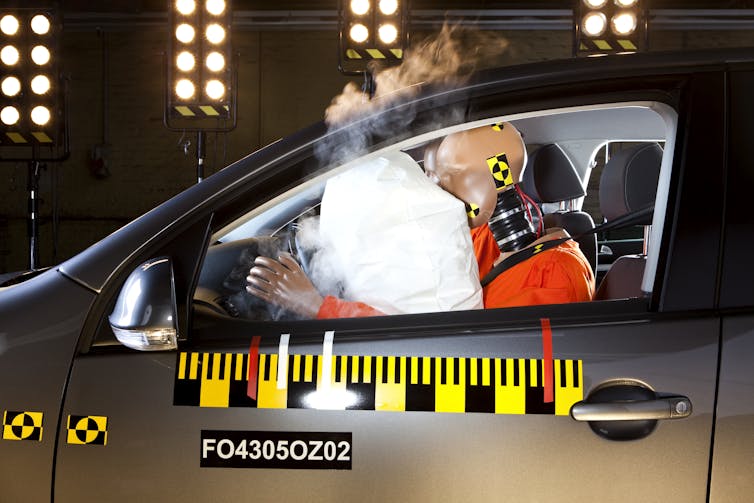Plane and car crash testing is still designed to keep men safe. That puts women in danger
- Written by The Conversation
The next time you board a commercial flight and are told how to sit in the brace position for an emergency landing, consider this: did you know that international plane safety testing only requires adult male crash test dummies?
Even with car crashes, male dummies are still used for the majority of crash tests worldwide and in Australia. Bizarrely, until just three years ago, the only supposedly “female” crash test dummies used in car safety tests were just shrunken versions of male dummies.
As a former airline pilot now completing a PhD in aviation safety, I’ve been researching the history of aeroplane and car safety. And I’ve been shocked at how little real-world testing is still being done to keep women safe in the air and on our roads.
The problem with crash test dummies
Crash test dummies, called “anthropomorphic test devices”, were first developed for the military in 1949, then adopted by the automotive industry in the mid-1960s.
One of the most widely used test dummies today for both aeroplanes and cars is the Hybrid III “average” man: 175cm tall, 78kg, first created in 1976. That’s meant to represent a 50th percentile or average-sized man and is even written into US regulations for certification safety testing.
Automotive safety testing does include a “small female” dummy for around 25% of tests. However, the dummy required to be used is not actually shaped like an average biological female.
Supposedly “female” dummies have been made and used over the years, such as the Hybrid HIII-5F.
But at just 149cm tall and 48kg, it’s more like the size of a 12-year-old girl. And this dummy (widely used in car testing, including in Australia) is actually a scaled down version of the widely used average male Hybrid III – with plastic breasts swapped in for its chest.
It was only three years ago that a team of Swedish engineers led by pioneering researcher Astrid Linder finally unveiled the first dummy built to mimic an “average woman” of 162cm and 62kg.
The creation of a new female dummy is a step forward. But using that more accurate “average” female dummy is not yet a legal requirement for car or plane testing.
Women’s higher risk of serious injuries in cars
In cars, women are more likely to be seriously injured in crashes, even at low speeds.
Women sit further forward than men when driving, even if they are the same height. We need to, as we have different limb proportions than men.
In crashes, women are often labelled “out of position drivers” — simply because car designs are based on the average male. Half the world’s population is not sitting wrong; it’s a design flaw.
Startlingly, some car protection systems designed and tested on male dummies have been shown to increase injury severity in women, while decreasing the injury in men.
Aeroplanes are only required to test with male dummies
When it comes to aeroplanes, all research, testing and aircraft certification – including seat and seat belt design, as well as the brace positions to adopt before a crash – use only “average” male dummies, such as the Hybrid III male dummy modified for aviation.
Aeroplanes get safety certified in the country they’re made. The two big global manufacturers are Boeing and Airbus. Boeing planes are assembled and certified in the United States by the Federal Aviation Administration, while parts of Airbus planes are built across Europe, China and Canada, certified by the European Union Aviation Safety Agency.
The US and the European Union aviation safety agencies largely harmonise their standards for crash-worthiness and safety testing through international agreements. They follow standards and recommended practices set by global engineering association, SAE International.
Other national authorities, such as Australia’s Civil Aviation Safety Authority, rely on those international safety certification standards, rather than each country re-testing aeroplanes.
The lack of aeroplane safety research for women
As just one example, US regulations for testing emergency landings are very clear about what to use in those safety tests: the average male dummy. There is no requirement to use a female dummy.
Though I have been searching for it, there has been no research on the effect this male-centric focus has on female aeroplane passengers or crew safety.
Despite clear evidence that women experience different — and often more severe — injury outcomes in car crashes, there is no publicly-accessible research on this in aviation.

Women are not simply smaller men
Body proportions, muscle mass and limb length differ between the sexes. Research into injuries from car crashes in the United Kingdom has found men possess 8% greater skeletal mass and a different body mass distribution than women.
Women generally have a smaller height and shoulder width, but a larger hip circumference than men. Female sex hormones lead to more lax ligaments, influencing joint stability.
Physiological differences between women and men matter to safety outcomes.
Such differences need to be considered in better future testing for aeroplanes and cars. One design does not fit all when it comes to safety.














